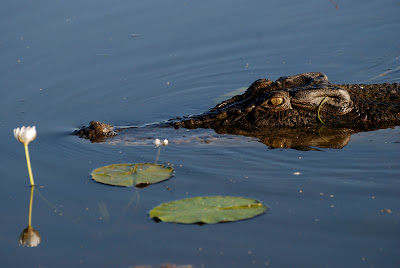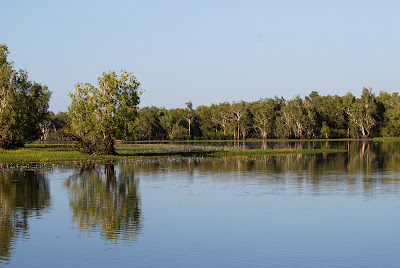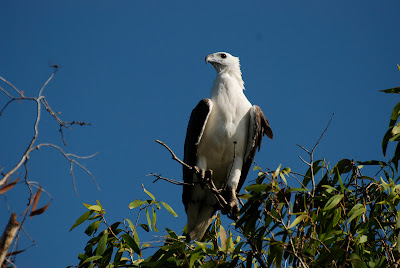At 6.30 the next morning I was waiting with a small group of other early risers for the courtesy bus down to the embarkation point. Ten minutes later we tumbled out of the bus and made our way out on a board walk through the belt of trees which still hid the wetland from us ...
A darter was waiting with outstretched wings to welcome us to its world ...
... while parties of commuting magpie geese were continually streaming overhead:
So this was where the wetland was hidden!
Yellow Water was my first billabong . Definitions vary, but the one most consistent with its usage in Kakadu is a permanant piece of water that is left as a watercourse dries out. Look at a map, and it appears to be part of a river, but travel up or down 'stream' (there is no flow at this time of year) and you will run out of water. The billabong-faring boat was a fairly standard tourist vessel - except that it had a quiet electric motor, and the space between the side rails was completely filled with a fine, but extremely heavy gauge, metal mesh. The tour guide (and boat operator) was skilled at placing the boat for the best views of the (largely avian) fauna, and the boat was only about half full so there was plenty of space to move around. What could be better?
Almost our first sighting was a small Estuarine crocodile. There are two species of crocodiles in Kakadu - the Estuarine and the smaller and shyer Freshwater crocodile. It's the Estuarine one that is the threat to humans. The ones living in salt water are pale in colour, but after they have spent some weeks living in freshwater they become dark as a result of an alga that grows on them. For those who don't know, Kakadu is where Crocodile Dundee was filmed. This croc was getting on for 3 meters, but many of the Estuarine crocodiles that we saw were about 4 meters. Definitely not to be tussled with.
The meadows alongside the water were busy with birdlife. This young Jabiru (Black-necked stork) had spooked the flock of wildfowl:
There were plenty of darters drying out after their early-morning fishing:
And this is the only Glossy ibis I've ever seen (outside a zoo) where the light revealed the purple-brown plumage coloration:
As well as being full of birds, the meadows alongside the water were beautifully peaceful:
We saw plenty more crocodiles, all keeping cool in the water as the day warmed up, even at the relatively early hour:
White-bellied sea eagle:
The red water lilies, which can cover large areas of water, are used by the aborigines - who probably traded for them in Papua New Guinea or further north, and introduced them to Australia - as food at certain times of year.
A Nankeen night heron:
How could I ever have doubted that Kakakadu was the place to be? I never did get to see Litchfield National Park or the Katherine Gorge.
* * *
On reflection, it's not difficult to work out why all the major roads in Kakadu go through woodland. It makes for boring driving, but means that they are passable for the largest part of the year. The aborigines recognise six seasons of the year. I was there during the period of pre-monsoon storm season - or Gunumeleng, as the aborigines call it. Although there may be rainstorms, it's still a period when the wetlands are drying out. Woodlands are so dry at this time that fires can cause catastrophic damage. The aborigines use fire as a regular part of the management of their environment, but don't burn during this season. At the end of the pre-monsoon season come the heavy monsoon rains, causing widespread flooding: instead of driving, the only way to travel from Jabiru (the town, not the bird after which it is named) to Ubirr, some 50 km to the east, is often to take a boat on the flood water. After this, the environment gradually dries out, until the next year's rains repeat the cycle.
The days are hot in Kakadu, so the best parts of the day to bird watch or walk are in the early morning or later afternoon. I soon fell into a pattern of rising at 6 am, 30 minutes or so before the sun rose, and planning my day so that I did most of the driving during the hottest part of the day (with the benefit of airco in the campervan when the engine was running). Two of the mornings I visited other wetlands on foot:
A jacana (or lily-trotter) which can run across wet mud (or floating lily leaves) with the aid of its long toes:
These beautiful dragonflies with 'picture wings' were quite abundant, and hunted in the dry grasses some way from the water's edge:

Perhaps the most spectacular wetland sight that I saw while in Kakadu was at 'Goose Camp', which I visited as part of a tour to experience aboriginal food-gathering techniques - not to see the wildlife. The wetland next to Goose Camp was jammed with a cacophany of wildfowl - mostly Magpie geese. Despite the almost continuous stream of flocks passing over head, the ground was still covered with them. I asked the guide if he knew how many there were. He shrugged his shoulders. Three hundred thousand? It's quite possible: there are a million Magpie geese in Kakadu at this time of year.
Kakadu is of immense conservation importance to a range of both plant and animal species. Ultimately, though, to concentrate solely on that is to miss its astonishing natural beauty.





















Thanks Kate,
ReplyDeleteYou're doing a wonderful job of making your trip so much fun for us too. Especially as it's dark and wet here in France today.
Brilliant info and superb photos. :O)
chp.
Just discovered something.
ReplyDeleteIf you double click onto one of the photos you get a bigger version of it come up. Really good quality too.
The young Jabiru (Black-necked stork) looks amazing and so does the shadow of him in the water. Crocodile is pretty impressive too, glad I wasn't that close to it though. :O)